|
|
|
Sort Order |
|
|
|
Items / Page
|
|
|
|
|
|
|
| Srl | Item |
| 1 |
ID:
181532
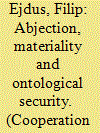

|
|
|
|
|
| Summary/Abstract |
Ontological security scholarship in International Relations (IR) has predominantly focused on the importance of social environments for the healthy sense of self. However, material environments can also provide an important source of ontological security. In my previous work I have argued that to assume this role of ‘ontic spaces’ material environments need to be discursively linked to states’ self-identity either through projection or introjection. In this article, I draw on the work of Julia Kristeva to argue that ontic spaces can also come about through abjection or the rejection of a material environment from the narrative of the self. I illustrate this theoretical point in the case study of the Serbian Orthodox Church of Christ the Saviour in Pristina. Its construction began in 1992 during the rule of Slobodan Milošević but was never finished due to the Kosovo war in 1998/9. Over the years, as all proposed changes are considered to be a threat to a healthy sense of self of either Serbs or Albanians, the building has been turned into an abjected ontic space, an ambiguous symbol undermining the self/other and victim/oppressor boundaries and as such both repels and attracts, threatens and protects.
|
|
|
|
|
|
|
|
|
|
|
|
|
|
|
|
| 2 |
ID:
151479
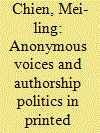

|
|
|
|
|
| Summary/Abstract |
This paper analyzes two versions of a printed genealogy collated by the Hmub and Kam in Eastern Guizhou, who gave authority to claims of consanguine bonds. It focuses on how the main text of the genealogy and other intertextual practices can either attribute authority to the genealogies or undermine it. On the one hand, elite accounts of ancestors in the genealogies invent a strong ideology of consanguinity that directly contributes to the text’s authority. At the same time, however, the use of Chinese characters to represent the Hmub phonetic system coexists with the Hmub system of patronymy within the assemblage of the individual descendant names. In other words, Chinese characters represent nonpersonal phonetic symbols of the Hmub language. This in turn means that anonymous voices can emerge in other texts. The result is a shift in the nature of authorship from an overtly collective authority to a covertly diffused anonymity.
|
|
|
|
|
|
|
|
|
|
|
|
|
|
|
|
| 3 |
ID:
112735
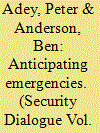

|
|
|
|
|
| Publication |
2012.
|
| Summary/Abstract |
In this article, we examine contemporary 'resilience' through UK preparedness - an apparatus of security enacted under the legal and organizational principles of UK Civil Contingencies and civil protection legislation and practices. By examining the design, practices and technologies that constitute the exercises performed within Civil Contingencies, the article first suggests that the manner in which exercises have been mobilized as examples of preparedness and apocalyptical imaginations of the 'unthinkable' should be understood within the highly specific societal and political contexts that shape them. More substantially, the article then provides a nuanced understanding of the life of the security assemblage through an in-depth analysis of the exercise and its design, materials, play and contingent relations. Seeking to deepen and widen concerns for what matters in security studies, animated by concern for objects, bodily affects, contingencies and excess, the article contends for a more serious concern with how security and its practices can surprise, shock, enthral and disrupt in a manner that need not only be associated with failure.
|
|
|
|
|
|
|
|
|
|
|
|
|
|
|
|
| 4 |
ID:
171965
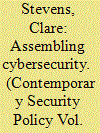

|
|
|
|
|
| Summary/Abstract |
This is an article about how cybersecurity gets “made,” with a focus on the role of commercial computer security firms in generating knowledge in matters of international cybersecurity. The argument is two-fold. Firstly, malware may be an intangible artefact in some ways, but its success and its interpretation as malware is deeply interwoven in social, technical, and material alliances. Secondly, a materialist-minded examination of Symantec’s Stuxnet reports will demonstrate the politically situated nature of how cybersecurity expertise emerges. The article finds that Symantec’s work was not a-political or neutrally-technical: Their experts made profoundly political choices in their analyses. By showing the processes that go into making cybersecurity, the article contributes to a widening and deepening of debates about what is at stake in cybersecurity knowledge and practices.
|
|
|
|
|
|
|
|
|
|
|
|
|
|
|
|
| 5 |
ID:
165014
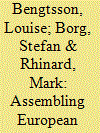

|
|
|
|
|
| Summary/Abstract |
The securitization of health concerns within the European Union has hitherto received scant attention compared to other sectors. Drawing on the conceptual toolbox of actor-network theory, this article examines how a ‘health security assemblage’ rooted in EU governance has emerged, expanded, and stabilized. At the heart of this assemblage lies a particular knowledge regime, known as epidemic intelligence (EI): a vigilance-oriented approach of early detection and containment drawing on web-scanning tools and other informal sources. Despite its differences compared to entrenched traditions in public health, EI has, in only a decade’s time, gained central importance at the EU level. EI is simultaneously constituted by, and performative of, a particular understanding of health security problems. By ‘following the actor’, this article seeks to account for how EI has made the hunt for potential health threats so central that detection and containment, rather than prevention, have become the preferred policy options. This article draws out some of the implications of this shift.
|
|
|
|
|
|
|
|
|
|
|
|
|
|
|
|
| 6 |
ID:
169997
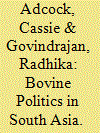

|
|
|
|
|
| Summary/Abstract |
This introduction outlines how the essays in this special section contribute to scholarship on cow protection in India. It argues that they disrupt three powerful framing binaries—religion/economy, legality/illegality and cow-lover/cow-killer—that have tended to dominate the literature on cow protection. Making tangible the analytical limits of these categories, the essays find new critical leverage in the everyday situated relationships between humans, bovines and the state. The essays are distinguished by their attention to bovines as creative and productive forces that are not mere symbols for human politics, but materially embodied and agentive beings that play a significant role in shaping the social and political worlds which emerge around them.
|
|
|
|
|
|
|
|
|
|
|
|
|
|
|
|
| 7 |
ID:
159866
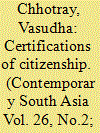

|
|
|
|
|
| Summary/Abstract |
Experiences in the post-partition Indian subcontinent refute the conventional expectation that the ‘possession of citizenship enables the acquisition of documents certifying it’ [Jayal 2013. Citizenship and Its Discontents: An Indian History. Cambridge, MA: Harvard University Press, 71]. Instead, identity papers of various types play a vital part in certifying and authenticating claims to citizenship. This is particularly important in a context where the history of state formation, continuous migration flows and the rise of right-wing majoritarian politics has created an uncertain situation for individuals deemed to be on the ‘margins’ of the state. The papers that constitute this special issue bring together a range of disciplinary perspectives in order to investigate the history, politics and materiality of identity documents, and to dismantle citizenship as an absolute and fixed notion, seeking instead to theorise the very mutable ‘hierarchies’ and ‘degrees’ of citizenship. Collectively they offer a valuable lens onto how migrants, refugees and socio-economically marginal individuals negotiate their relationship with the state, both within South Asia and in South Asian diaspora communities. This introduction examines the wider context of the complex intersections between state-issued identity documents and the nature of citizenship and draws out cross-cutting themes across the papers in this collection.
|
|
|
|
|
|
|
|
|
|
|
|
|
|
|
|
| 8 |
ID:
143664
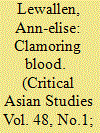

|
|
|
|
|
| Summary/Abstract |
The tension between silence and vocalization, embrace and rejection, of Ainu ancestry has been a key factor in negotiating Ainu subjectivity since Ainu territories were colonized in 1869. As early as 1799, expressions of Ainu ethnicity were alternately cloaked and exaggerated as Japan vacillated between assimilation and segregation policies in eastern Hokkaido Ainu communities. Officially recognized as Japan's indigenous peoples in 2008, Ainu subjectivity has become increasingly politicized as the state and other stakeholders seek to define Ainu ethnicity for future legislation. Today Ainu belonging is frequently gauged by bodily metaphors of a vocalized blood. Cultural sensibility and blood are often conflated in Ainu discourses of identity: Ainu revivalists report that a sensation of “clamoring blood” (J: chi ga sawagu) inspires them to revisit ancestral memories and begin fashioning Ainu identities. Historically, intra-Ainu relations were not bound to blood but instead embodied in material expressions, such as invisible cords for women and crest-like emblems for men, symbols that enabled flexibility where needed. Since the twentieth century, the hyper focus on blood raises the specter of colonially imposed rhetorics of eugenics, assimilation policies, and specifically, the problem of race. Relatedness in the Ainu community is not exclusively defined by “consanguineal relations”; rather, a long history of adopting ethnic Japanese children and non-Ainu into Ainu families renders complex the question of identity. This article assesses how immutable notions of racial difference intersect with self-determination and current articulations of Ainu identity.
|
|
|
|
|
|
|
|
|
|
|
|
|
|
|
|
| 9 |
ID:
106074
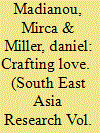

|
|
|
| 10 |
ID:
131248


|
|
|
|
|
| Publication |
2014.
|
| Summary/Abstract |
Recent scholarship in critical security studies argues that matter matters because it is not an inert backdrop to social life but lively, affectively laden, active in the constitution of subjects, and capable of enabling and constraining security practices and processes. This article seeks to further the debate about materiality and security. Its main claim is that materials-oriented approaches to security typically focus on the place of materials and objects within technologies and assemblages of governance. Less often do they ask how materials and objects become entangled in political controversies, and how objects mediate issues of public concern. To bring publics and contentious politics more fully into the debate about the matter of security, the article engages with Latour's work on politics, publics and things - or dingpolitik. It then connects the theme of dingpolitik to a particular controversy: Human Rights Watch's investigation of Gaza civilians allegedly killed by Israeli drone-launched missiles in 2008-2009. Drawing three lessons from this case, the article explores how further conversation between dingpolitik and security studies can be mutually beneficial for both literatures.
|
|
|
|
|
|
|
|
|
|
|
|
|
|
|
|
| 11 |
ID:
138072
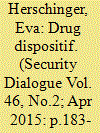

|
|
|
|
|
| Summary/Abstract |
International relations and critical security studies are increasingly including the role of materiality in the study of security practices, inquiring into how objects act as both threat and /or endangered referent. However, objects of ‘dual-use’ – that is, objects that are not only threatening or in need of protection but also beneficial or pleasurable to the human collective – figure less prominently. Drugs are such an ambivalent matter: beneficial in the context of medicine and at the same time threatening in the context of crime. Mobilizing the concept of the dispositif, this article questions how drugs and addiction materialize in the practices of the global drug prohibition regime. I argue that the ambivalence of the material object ‘drug’ is the condition of possibility of the regime. The regime as an epitome of the ‘drug dispositif ’ illustrates how ambivalent objects give rise to expanding security practices and specific power relations, highlighting how (critical) security analyses could profit from greater awareness of ambivalent matters.
|
|
|
|
|
|
|
|
|
|
|
|
|
|
|
|
| 12 |
ID:
123589
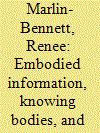

|
|
|
|
|
| Publication |
2013.
|
| Summary/Abstract |
The turn to materialism emerging in world politics scholarship promises fruitful ways of understanding power and political life by focusing on agency in the physical world. Yet immaterial information and 'the virtual' seem to dominate our lives. How can we understand the relationship between the material and the informational? Does this understanding promise any further insight into agency, power, and world politics? The focus in this paper is on the materiality (corporeality) and information of the human body as a special case. Embodied information is the information contained in the body that can potentially be accessed by others through an act of power. The way in which embodied knowledge is implicated in practices of world politics is exemplified by surveillance, DNA databases, and organ trade. Bodies are also the means by which information becomes sensible: we understand information from various sources and with various kinds of content through our bodies' ability to sense. This knowing body is also implicated in power, as exemplified by the use of sound and the augmentation of the senses through technology. Drawing on the interpretation of embodied information and knowing bodies, this article provides a pragmatic model of world politics in which to control how information flows, how it is extracted from the body, how it is inserted or received, how quickly, and to what end, is to have power or to be powerful.
|
|
|
|
|
|
|
|
|
|
|
|
|
|
|
|
| 13 |
ID:
170758
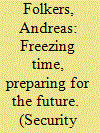

|
|
|
|
|
| Summary/Abstract |
This article analyses stockpiling as a security device that hoards time, stores power and buffers disruptions. The stockpile is a temporal matter of security by virtue of its ability to freeze time and to prepare for future emergencies. Stockpiling is informed by anticipations of threats but also materially underpins expectations. After unpacking the temporal ontology of stockpiling, the article traces its history as a security device and technology of power. Stockpiling enabled the emergence of the earliest states by establishing the means to store surpluses and centralize power. In modernity, stores became more dispersed as money, commodity exchange and new infrastructures made it possible to procure resources through circulation. In the 20th century, stockpiling became a reflexive security device reactive to risks associated with the disruption of these circulations. Finally, the article illuminates the role of reserves in contemporary German catastrophe preparedness to show that stockpiling remains an important security technique. Yet fiscal austerity and budgetary constraints limit security stockpiling. To compensate for the absence of public security stores, the government is prompting citizens to establish emergency stockpiles. The article offers a theoretical, historical and empirical engagement with stockpiling and thereby further elucidates the material politics of anticipation.
|
|
|
|
|
|
|
|
|
|
|
|
|
|
|
|
| 14 |
ID:
109878


|
|
|
|
|
| Publication |
2012.
|
| Summary/Abstract |
This article seeks to provoke a deeper engagement of Critical Security Studies with security's relations to technology and weapons. It explores existing assumptions about these relations in mainstream arms control and disarmament theory, and the way such assumptions are deployed and distributed in the current settlement of arms control and disarmament practice. It then draws on recent social and philosophical discussions of materiality, particularly on the thought of Bruno Latour, to propose a different set of concepts for exploring the aims and limits of arms control and disarmament. These concepts emphasise the mediating roles of material things in social relations and they may offer a richer view of the object of arms control (weapons and violence) and of the practices of arms limitation and reduction; one that may ultimately gesture towards a different understanding of arms politics, and that may be used to explore the transformatory potentials of arms control and disarmament.
|
|
|
|
|
|
|
|
|
|
|
|
|
|
|
|
| 15 |
ID:
143309
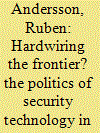

|
|
|
|
|
| Summary/Abstract |
Migration controls at the external EU borders have become a large field of political and financial investment in recent years – indeed, an ‘industry’ of sorts – yet conflicts between states and border agencies still mar attempts at cooperation. This article takes a close look at one way in which officials try to overcome such conflicts: through technology. In West Africa, the secure ‘Seahorse’ network hardwires border cooperation into a satellite system connecting African and European forces. In Spain’s North African enclaves of Ceuta and Melilla, advanced border fencing has joined up actors around a supposedly impenetrable divide. And on the EU level, the ‘European external border surveillance system’, or Eurosur, papers over power struggles between agencies and states through ‘decentralized’ information-sharing – even as the system’s physical features (nodes, coordination centres, interfaces) deepen competition between them. The article shows how such technologies, rather than ‘halting migration’, have above all acted as catalysts for new social relations among disparate sectors, creating areas for collaboration and competition, compliance and conflict. With these dynamics in mind, the conclusion sketches an ‘ecological’ perspective on the materialities of border control – infrastructure, interfaces, vehicles – while calling for more research on their contradictory and often counterproductive consequences.
|
|
|
|
|
|
|
|
|
|
|
|
|
|
|
|
| 16 |
ID:
144783
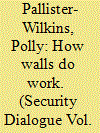

|
|
|
|
|
| Summary/Abstract |
What do security barriers do beyond blockading or demarcating territory? This article argues for an understanding of security barriers as sociotechnical devices. It argues for a rearticulation of security barriers as more than territorial technologies or the products and producers of sovereign power. It advances the discussion of security barriers beyond what can be thought of as a ‘geopolitics of security’, where the referent object is territory, and asks that we also consider how they work with mobility as productive devices to govern people in a variety of ways. The article empirically analyses the fences of Ceuta and Melilla, the barriers of Israel’s occupation of the Palestinians, and the US counterinsurgency fence in Falluja. Building on these illustrative cases, the article argues that security barriers should be understood as products of particular modes of government and producers of particular populations through their ability to perform interruptions and capture data.
|
|
|
|
|
|
|
|
|
|
|
|
|
|
|
|
| 17 |
ID:
192619
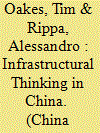

|
|
|
|
|
| Summary/Abstract |
Despite China's leading role in the construction of infrastructure over the past decades, the most influential paradigms for the study of infrastructure in the social sciences originate from research conducted elsewhere. This introduction to the special section “Chinese Infrastructure: Techno-politics, Materialities, Legacies” seeks to address this apparent gap, and contributes to building an innovative research agenda for an infrastructural approach in the China studies field. To do so, it pushes forward an understanding of infrastructure as both an empirically rich material object of research and an analytical strategy for framing research questions. We draw from two strands of inquiry: recent efforts to rethink the materiality of infrastructures not as an inert or stable basis upon which more dynamic social processes emerge, but rather as unstable assemblages of human and non-human agencies; and scholarship that explores the often hidden (techno-)political dimensions of infrastructures, through which certain intended and unintended outcomes emerge less from the realms of policy and implementation and more from the material dispositions and effects of infrastructural formations. These strands of inquiry are brought together as part of our effort to recognize that the infrastructural basis of China's approach to development and statecraft deserves a more concerted theorizing of infrastructure than we have seen thus far.
|
|
|
|
|
|
|
|
|
|
|
|
|
|
|
|
| 18 |
ID:
175121
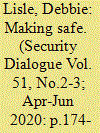

|
|
|
|
|
| Summary/Abstract |
In the Ulster Museum’s new gallery The Troubles and Beyond, the central display showcases a Wheelbarrow bomb disposal robot. This machine was invented by the British Army in Northern Ireland in 1972 and used by officers of the 321 Explosive Ordinance Disposal Squadron (321EOD) to defuse car bombs planted by the Irish Republican Army (IRA). This article offers an alternative history of that machine – a dirtier history – that critically assesses its role during the Troubles. Centrally, the article contests the British Army’s preferred account of this machine as a ‘game-changing’ technological innovation in counterinsurgency, and their understanding of themselves as benign peacekeepers. Rather than figure the Wheelbarrow robot as an unreadable ‘black box’ used instrumentally by the superior human operators of 321EOD, this article seeks to foreground the unruly transfers of agency between the machine and its operators as they tested and experimented in the exceptional colonial laboratory of Northern Ireland. The article further explores the machine’s failures during bomb disposal episodes, the collateral damage that resulted, and the multiple and often unruly reactions of local populations who watched the Wheelbarrow robot at work. Providing a ‘dirty history’ of the Wheelbarrow robot is an effort to demonstrate that war can never be fully cleaned up, either through militarized mythologies of technological innovation or hopeful museum displays.
|
|
|
|
|
|
|
|
|
|
|
|
|
|
|
|
| 19 |
ID:
106365
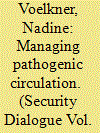

|
|
|
|
|
| Publication |
2011.
|
| Summary/Abstract |
This article traces the emergence of human security as a situated political strategy for managing the circulation of pathogens relating to Burmese migrant communities in Thailand. Specifically, it focuses on the intricate and productive interplay of a range of human and non-human elements that helped to bring forth and shape the vernacular micropolitics of human security. The article documents the techno-(bio)political mechanisms of the human security intervention in two of Thailand's provinces. By enframing, ordering and depoliticizing the complex health world of Burmese migrants in terms of simple dichotomies in which 'unruly' nature (pathogens, diseases, bodies) is contrasted with human techno-scientific ingenuity (scientific evidence, technological innovations, managerial effectiveness), these mechanisms render the circulation of pathogens amenable to biopolitical governance. It is here argued that in the struggle to manage pathogenic circulation, human security transforms the issue of migrant health into a technical matter concerned with the (self-)management of bodies and the governmentalization of the Thai state to the exclusion of important but difficult questions concerning a violent politics of exclusion.
|
|
|
|
|
|
|
|
|
|
|
|
|
|
|
|
| 20 |
ID:
142500
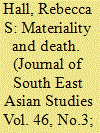

|
|
|
|
|
| Summary/Abstract |
Visual arts maintain a colourful presence at Buddhist funerals in Northern Thailand. These arts are not made for mere decoration but serve an active and essential role in the ceremonies that take place after death. They echo funerary themes of the impermanent nature of life and the importance of a life filled with merit. This article examines cremation structures and funeral banners of Northern Thailand and argues that these arts not only hold significance for the living and the dead, but that in giving form to abstract concepts they have the power to guide observers in their beliefs regarding the dynamics of life and death.
|
|
|
|
|
|
|
|
|
|
|
|
|
|
|
|
|
|
|
|
|